
Helpful_Hints_for_IELTS
.pdf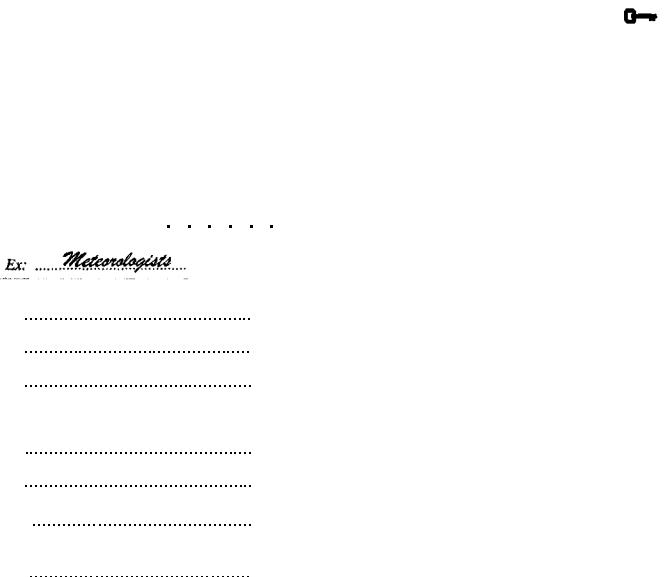
Practice Test Two
Questions 5-11
You are advised to spend about 8 minutes on Questions 5-11.
Look at the table below. According to Reading Passage 1, to whom or what do the phrases on the right refer? Write your answers in boxes 5 -11 on your Answer Sheet. The first one has been done for you as an example.
Note that you must give your answer IN NO MORE THAN THREE WORDS.
6
8
44-46
53
Who or What |
? |
|
have improved their forecasts for hurricanes. |
Q5 |
... become stronger every few decades. |
Q6 |
... energises all hurricanes. |
Q7 |
... is a huge current of water flowing from |
|
north to south. |
Q8 |
... could not stay in the air for a long time. |
Q9 |
... know more about surface winds than |
|
they knew before. |
Q10 |
... recently predicted a catastrophe for the |
|
city of New York. |
Qll |
... is a huge wave of water blown on land |
|
by a hurricane. |
Questions 12 -15
You are advised to spend about 7 minutes on Questions 12-15.
Refer to Reading Passage 1, and decide which of the answers best completes the following sentences. Write your answers in boxes 12 -15 on your Answer Sheet. The first one has been done for you as an example.
Example: The main point of the passage is to give information about:
a)previous U.S. hurricanes
b)future U.S. hurricanes
c)forecasting hurricane activity
 why hurricanes change in intensity
why hurricanes change in intensity
9
65'
49
44
44
49-65
42-43
42-49
Check 11-15
6
8
30-33
40-43
9
115

101 Helpful Hints for 1ELTS
52 Q12. The intensity of U.S. hurricanes:
a)has increased by 15 to 30% recently
by depends on the GPS-dropwindsondes
c)was greater from 1940 to 1969 than at any previous time
d)can be more accurately measured by satellite assistance
31-52 |
Q13. The Category 4 hurricane which hit Florida in 1926: |
a)was the most catastrophic to hit the U.S. this century
b)caused $77 billion worth of damage
c)caused an explosion in population growth
d)none of the above
35-52 Q14. Hurricane'Camille':
a)caused $1.5 billion dollars damage in today's money
b)was the worst U.S. storm this century in terms of life lost
c)was named in the 1950s
d)was not as intense as the hurricane of 1926
Q15. The writer of the passage probably believes that:
a)accurate tracking of hurricanes might be possible in the future
b)storm surges only occur within computer simulations
c)computer predictions are unreliable
d)the worst hurricanes occur in the U.S.
Check:
11-13-15
116

Practice Test Two
Reading Passage 2
Questions 16-28
You are advised to spend about 20 minutes on Questions 16 - 28.
TERTIARY COMPARISON GUIDE
After purchasing a house and a car, the next major life expenditure is almost certainly the cost of tertiary education. The question is, are prospective university students getting value for money? Paying up to $25,000 for a university education, they need reliable information in order to compare institutions and courses.
There are now two official guides comparing universities, but not courses. As a result, academic controversy has arisen over their adequacy, and because ofconcerns about comparability and accuracy of data. When comparing universities, one should be aware ofwhat exactly is being measured, and whether the information is useful. Professor Brian Smith, Vice-Chancellor of the University of Western Sydney, says, "There is as much variation within one university as between universities; no university has all thebestactivities, and no university is without its strengths".
It makes little sense for prospective students to choose to go to auniversity simply because it has an excellent reputation. It is wiser to look first at the overall characteristics and reputation of a university, and then at the faculty or discipline desired. To do this one must have access to quality data for each discipline.
Let us look at three ways we can now rank universities. A government-appointed Quality Review Committee made the first ranking ofunversities in 1993. It divided the 35 universities in Australia into six quality bands based mainly on research and teaching outcomes. In the top band, only two universities were represented: one fromNSW (the University of NSW) and the other from the ACT (the AustralianNational University).
Sydney and Wollongong universities were
both in the second ranking. Wollongong was 54.56.57 the only neweruniversity to make such ahigh
grade. Macquarie and the University of Technology, Sydney, were in band four; Charles Sturt, Canberra, New England, and Newcastle were in band five. In band six were the Australian Catholic University and the University of Western Sydney.
This ranking has drawn much criticism, since it was based on what universities spent on research, and not on the quality ofteaching. However, it should be stated that this was the first year of a continuing quality review. Next, the Quality Review Committee will assess the teaching record of universities.
The Department of Education Employment and Training (DEET) has published 50 indicators of diversity and performance ofAustralian universities. This lists comparative data on everything from academic staff ratio and percentage of staff with PhDs, to expenditure on library grants. The document says it does not rank universities, and is designed to assist students to make informed comparisons. But the universities can be ranked by each measure using a key indicator of success - positive graduate outcomes - which combines the percentage of recent graduates in full-time work and/or full-time study.
Here, the University of Technology, Sydney, emerges as the leader in NSW, with 83.2% of its graduates in work and/or study, just behind the ANUwith83.5%. Sydney has 79.8%, Charles Sturt 75.5%, Wollongong 74.1%, Macquarie 73.2%, UNSW 73.1%, Newcastle 72.5%, New England/Southern Cross 72%, and Western Sydney 69.7%.
Professor Gannicort, a Professor of Education at Wollongong University, has developed his own "performance table", ranking Australian universities using some
117
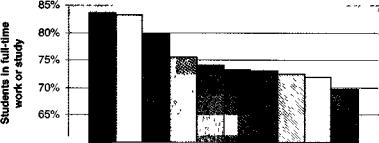
101 Helpful Hints for IELTS
of the DEET data - including the number of government research grants and grants from industry, as well as the number of recent graduates in full-time work or study. This time the University of Queensland tops the league. Sydney is third, UNSW fifth, ANU sixth, Macquarie 10th, Newcastle 15th, and all the other NSW universities well down in the rankings. He says this shows that the key factors which determine better university performance are what has always been supposed: that is, high quality students, numerous well-qualified staff, and nonproliferation of courses.
Interestingly, Ms. Barbara Bell, the National Recruitment Manager for the Institute of Chartered Accountants, claims employers are not so much interested in the university as in the skills and all-roundquality of graduates. Those graduates who lack communication skills, for example, are at a big disadvantage. Ms. Bell quotes a recent survey that found a quarter of employers of
graduates chose not to rank universities "because they said there was no correlation between the university and performance".
Dr. Michael Dack, Public Affairs Director ofthe Institution ofEngineers, has commented that the prestige of a university does not count. The smaller universities are tailoring courses andproducts to the marketplacebetter than the large universities. They are trying harder to produce graduates who are acceptable to industry and employers. Traditional universities are often more academic and less industry-linked. He argues strongly the case for more broadly educated graduates. For example, the trend in engineering was to produce graduates with a broader education, communication and financial skills, and knowledge of the environmental and political context. Engineers with other skills were able to weather times of economic recession much better.
Figure 1. Australian Universities -
Positive Graduate Outcomes
|
ANU |
|
UTS |
|
Sydney |
|
Charles Sturt |
|
Wollongong |
|
Macquarie |
|
UNSW |
|
Newcastle |
60% J |
Southern Cross |
Western Sydney
10 Australian Universities
118

Practice Test Two
Questions 16-23
You are advised to spend about 10 minutes on Questions 16-23.
Refer to Reading Passage 2 "Tertiary Comparison Guide", and look at the statements below. Write your answers in boxes 16 - 23 on your Answer Sheet.
Write |
A |
if the statement is Accurate |
|
I |
if the statement is Inaccurate |
|
N |
if the information is Not Given in the text |
The first one has been done for you as an example.
6
8
34-36
43-44-46
Example: There are now two official university comparison guides available. |
9 |
I N
Q16. Prospective students should consider the reputation of the university before choosing the faculty.
A I N
Q17. The university ranking system by the Quality Review Committee was well-received by students.
A I N
Q18. The Quality Review Committee's basis for determining the ranking was the quality of tuition.
A I N
Q19. The Committee will next review the amount universities spend on research.
A I N
Q20. The DEET study was conducted to assist students to compare information about universities.
A I N
Q21. More than a third of the universities in the DEET study have 75% or more of their recent graduates in work and/or study.
34
46 -
44
44
44
54
A |
I |
N |
|
Q22. According to employers, the ranking of universities does not assist in the |
43 |
||
determination of performance. |
|
|
|
|
|
|
|
A |
I |
N |
|
Q23. In order to compare disciplines or faculties, students need access to quality data.
A I N
44
Check: 11-13-15-
119

|
101 Helpful Hints for IELTS |
||
|
Questions 24 - 28 |
||
6 |
You are advised to spend about 10 minutes on Questions 24 - 28. |
||
8 |
Complete the sentences below with words or phrases from Reading Passage 2 "Tertiary |
||
46 53 |
Comparison Guide". Write your answers in boxes 24 - 28 on your Answer Sheet. The first one |
||
|
has been done for you as an example. |
||
|
Note that each answer requires a MAXIMUM OF THREE WORDS. |
||
9 |
Example: |
The |
cost of tertiary education is a |
44 |
|
Q24. |
University courses were not compared, which was one reason why the two |
|
|
official comparison guides caused |
|
44 • 53• 65 |
Q25. The government-appointed Quality Review Committee ranked Australia's |
|
universities within |
43 • 57 |
Q26. In order to rank universities, some of the DEET data was used by Professor |
|
Gannicort to produce a |
44-54-65* Q27. The ANU scored highest when positive
were used as the key indicators of success.
43-53-57 Q28. Employers are unlikely to employ graduates who
Check.
11-15
120
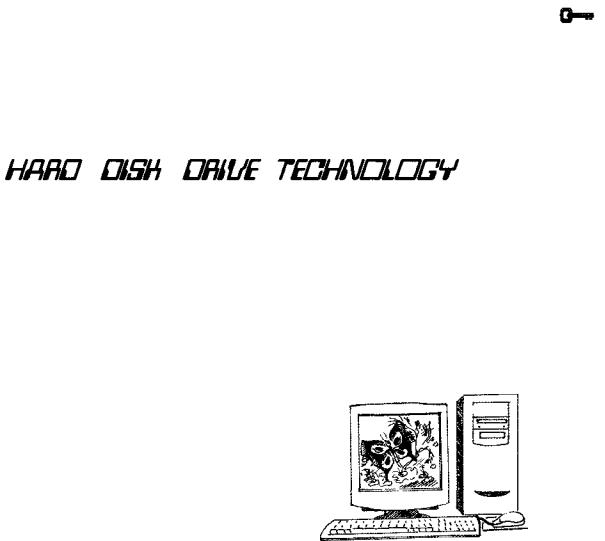
Reading Passage 3
Questions 29 - 40
You are advised to spend about 20 minutes on Questions 28 - 40.
Practice Test Two
6
38-44
50-56-57
A few years ago, a query about the health of a person's hard disk drive would have been met with a blank stare. Nowadays, almost everyone is aware of this remarkable electronic storage medium that is part of every modern computer, even though most users remain ignorant of the complexity of hard drive technology.
In the early days ofcomputing, an informationrecord ofa computer's memory content was kept on punched cards similar to the way in which an automated piano stores the keynote sequences on apiano roll. Later, magnetic tape was usedto store electronic signals, and is still the favoured means ofeconomically backing up the contents ofhard drives. However, accessing information sequentially stored on tape is slow since the electroniodata
must be input through a fixed head in a single pass.
Hard disk drives solve this problem by incorporating a spinning platter on which magnetic data can be made accessible via a moving head that reads and writes information across the width of the disk. It is analogous to the way in which a person can choose to play a particular track on a CD player by causing the arm to move the head across the disk. The CD player is, in fact, necessarily
similar in design to a hard drive, although there are significant differences in speed of data access.
Most modern hard drives incorporate several platters to further reduce the time spent seeking the required information. Also, some newer drives have two heads; one for reading, and a second head for writing data to disk. This separation of tasks enables much higher densities of magnetic information to be written on the platter, which increases the capacity ofthe hard drive.
There are three important ways in which the capacity of hard disks has been increased. First, the data code itself has been tightened with express coding techniques. Second, as previously noted, the head technology has been improved; and third, the distance between the heads and the platters has been greatly reduced. It is hard to believe, but the head can be made to pass over the magnetised platter at distances of less than 1 microinch (the width of a typical human hair is 5000 microinches). This is achieved by means of a special protective coating applied to the platter. Each of these three improvements enables speedier access to the data.
Hard drives are more commonplace thantape recorders these days, but it must be remembered that they are much more fragile. Treated with respect they may last a number ofyears, but they are quite easily damaged, oftenwith disastrous consequences for the user, whoseprecious data can become lost forever. Dropping a drive is almost always fatal, as is passing an incorrect electrical current through one (by faulty connection). Dust and even extremes of temperature can cause failure. Yet, no physical damage can ever result from the input of data via the keyboard or mouse. Ofcourse, over time the magnetised coating on the platters will erode, yet this is almost entirely independent of the amount of use.
121
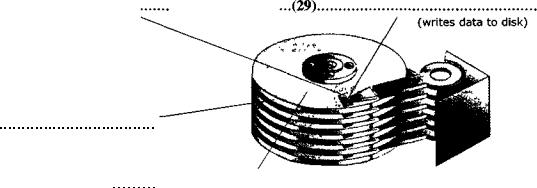
6
8
12-65'
9 / 4 4
44 56
44-57
101 Helpful Hints for IELTS
There are serious questions being raised about the direction of the future of electronic storage media. Some researchers claim that it would be wiser to invest more time and money in setting up systems for streaming data across networks of computers from centralised banks of information storage. This would avoid the need for each personal computer user to have his or her own copy of a software program resident on a local hard drive. Personal data files could be kept at a central storage unit, and be suitably protected from disaster by a failsafe backup system.
As the Internet becomes ever more pervasive, and the speed of access to other machines increases across our telephone lines, it might be possible to do away with local storage systems altogether.
Glossary: |
|
|
backing up |
- |
duplicating |
sequential(ly) |
- |
in sequence (or one after the other) |
platter |
- |
circular disk or plate |
Streaming data |
- |
sending or broadcasting information as data |
|
|
|
Questions 29 - 31
You are advised to spend about 5 minutes on Questions 29-31.
Referto Reading Passage 3 "Hard Disk Drive Technology" and the diagrambelow. Choose from the words and phrases in the given list, and label the diagram with the correct name ofeach part of the hard drive. Write your answers in boxes 29 - 31 on your Answer Sheet. The first one has been done for you as an example.
Note that you will not need to use every word or phrase in the list.
LIST OF PARTS: |
|
|
CD player |
second head |
magnetic tape |
moving head |
data code |
platter |
electrical current |
special protective coating |
|
|
|
|
...(Ex:).
(reads information across the width of the disk)
...(30)
(each contains magnetised areas for data storage)
...(31)
(shortens the required distance bettween the head and the platter to less than 1 microinch)
122

Practice Test Two
Questions 32 - 36 |
|
|
|
You are advised to spend about 7 minutes on Questions 32 - 36. |
6 |
||
Refer to Reading Passage 3 "Hard Disk Drive Technology", and decide which ofthe answers best |
s |
||
completes the following sentences. Write your answers in boxes 32 - 36 on your Answer Sheet. |
|
||
The first one has been done for you as an example. |
|
||
Example: |
Nowadays, hard disk drive technology is: |
9 |
|
|
a) |
less complex |
|
|
fb)) |
part of every modern computer |
|
|
c) |
expensive |
|
|
d) not difficult to understand |
|
|
Q32. |
Magnetically-coated disks are one of many types of: |
so |
|
|
a) sequential access information systems |
|
|
|
b) |
information storage solutions |
|
|
c) |
tape storage solutions |
|
|
d) |
CD players |
|
Q33. Connecting a hard drive incorrectly usually: |
so |
||
|
a) results in excess temperature |
|
|
|
b) erodes the magnetised material on the platters |
|
|
|
c) damages the keyboard or mouse |
|
|
|
d) |
destroys the drive |
|
Q34. Keyboard or mouse use can easily cause: |
31 |
||
|
a) |
incorrect electrical currents |
|
|
b) the magnetised coating on the platter to wear out |
|
|
|
c) physical damage to the hard disk drive |
|
|
|
d) none of the above |
|
|
Q35. In the future, a computer user might be able to access personal data files from: |
31 |
||
|
a) a central storage unit |
|
|
|
b) a local hard drive |
|
|
|
c) |
a software program |
|
|
d) |
the local bank |
|
Q36. |
Centralised banks of storage information could: |
3150 |
|
a)offer better protection of a user's data files
b)stream data across telephone lines
c)mean the end of local storage systems
|
Check: |
d) all of the above |
11 • 13 • 15 |
123
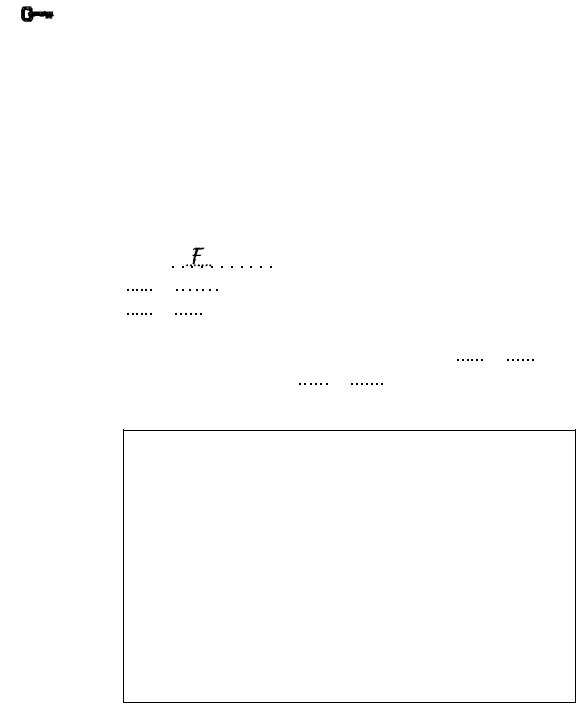
6
8
43-47
50-55-56
-6
101 Helpful Hints for IELTS
Questions 37-40
You are advised to spend about 8 minutes on Questions 37 - 40.
The following following text is a summary of part of Reading Passage 3. Complete each gap in the text by choosing the best phrase from the box below the summary. Write your answers in boxes 37 - 40 on your Answer Sheet.
Note that there are more phrases to choose from than are required. The first one has been done for you as an example.
Hard disk drives are exceedingly complex and fragile pieces of equipment, but
9
7-12-44
Overall Check:
Blanks: |
11 |
Grammar |
12 |
&SS
One Answer: 13
Spelling: 14
Legibility: 15
Punctuation: 5 9 1
...(Ex:) |
The cheapest way to store computer information is |
(37)However, it is slow to read back stored information in this way.
(38), on the other hand, consists of one or more spinning platters coated with magnetised material holding data made accessable by two moving heads.
Modern advances indisktechnology haveincreased the |
(39) |
ofharddisks. |
|
This has been accomplished |
(40) |
|
|
A.storage capacity
B.on magnetic tape
C.most computer users know that a hard disk drive is complex
D.a CD player is faster than a disk drive
E.A hard disk drive
^F. few computer users are aware of this
G.in three ways
H.cost
I.increasing the size of the platters used
J.size of the heads
That is the end of Practice Reading Test Two.
Now continue with Practice Writing Test Two on page 125.
124
